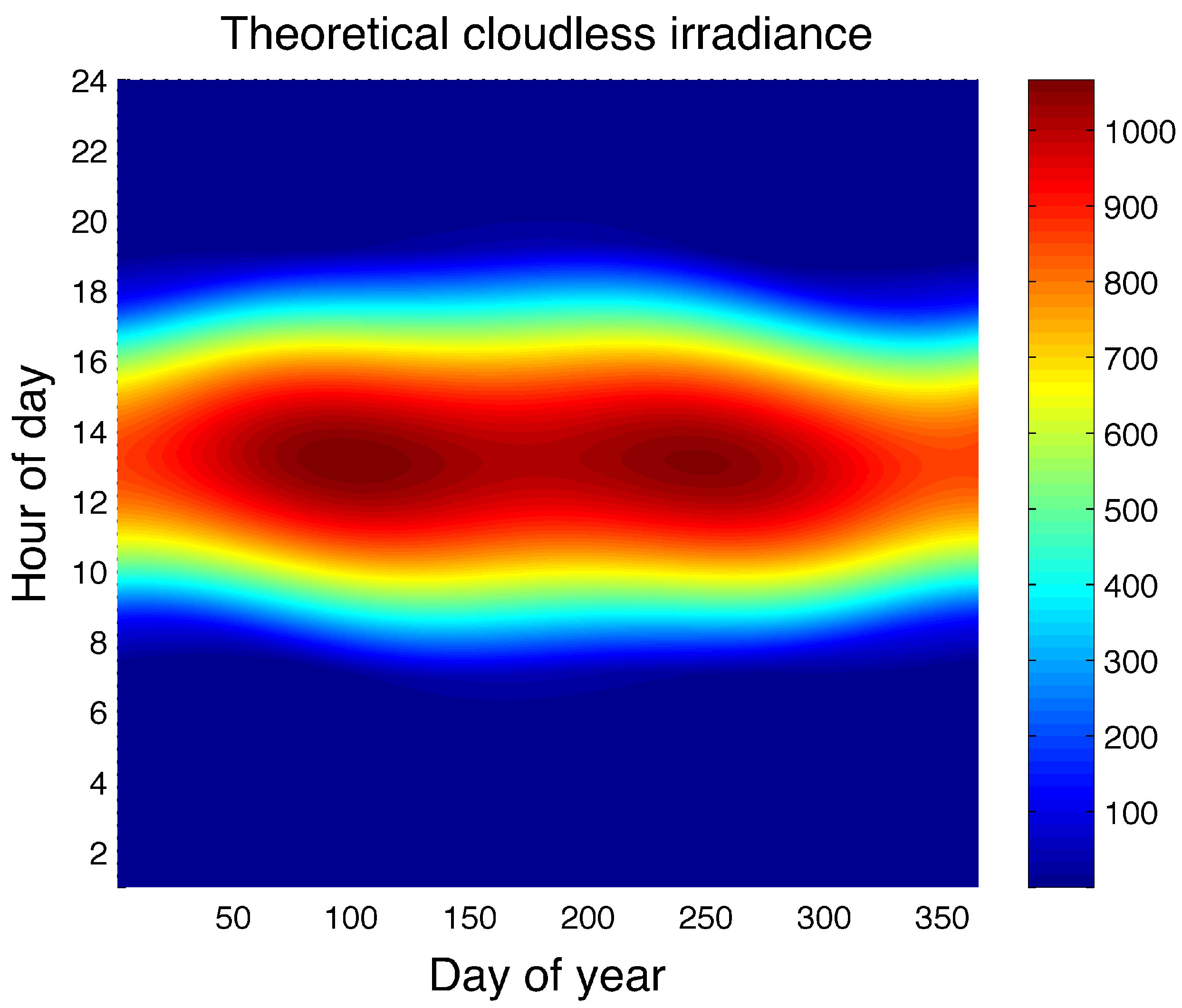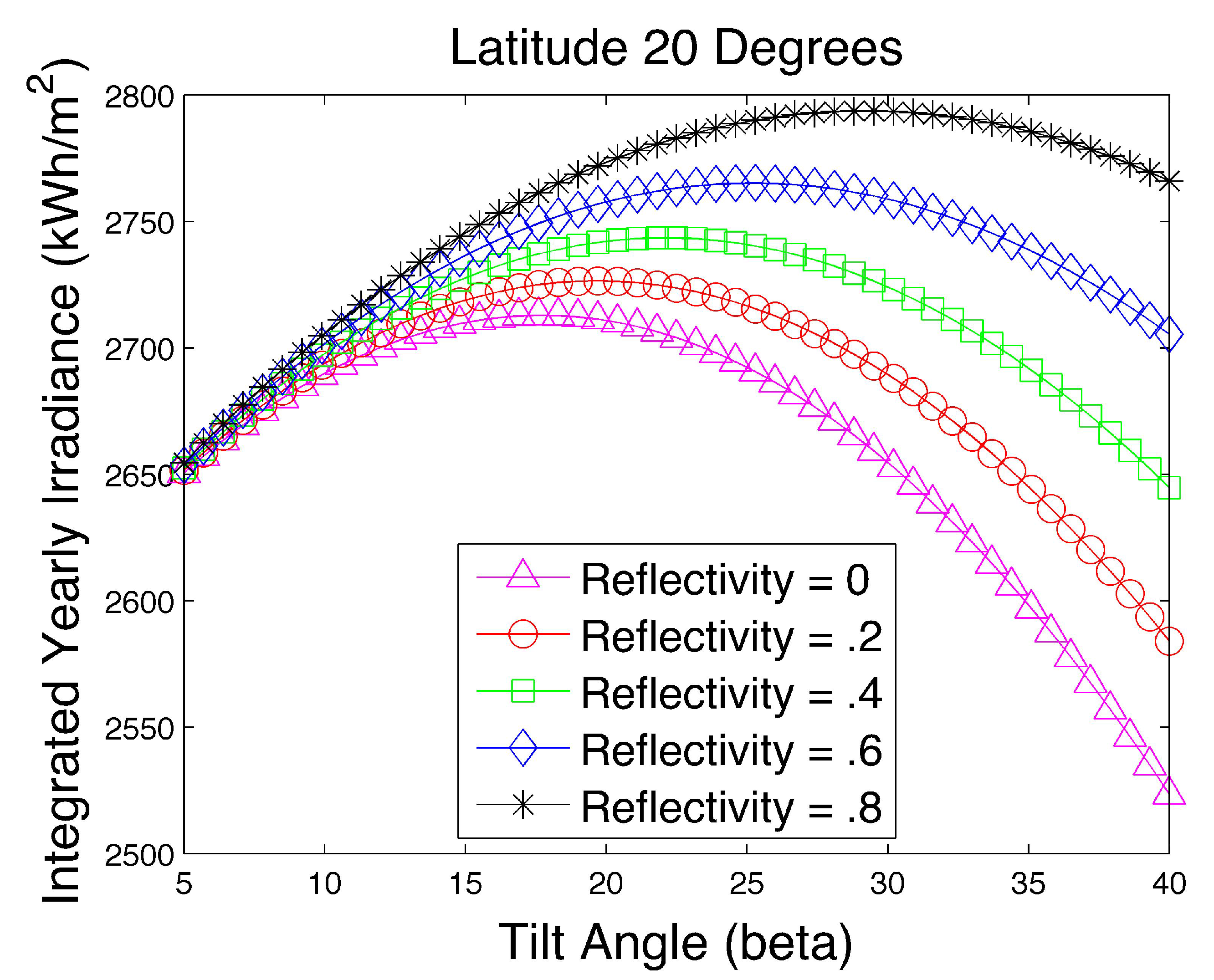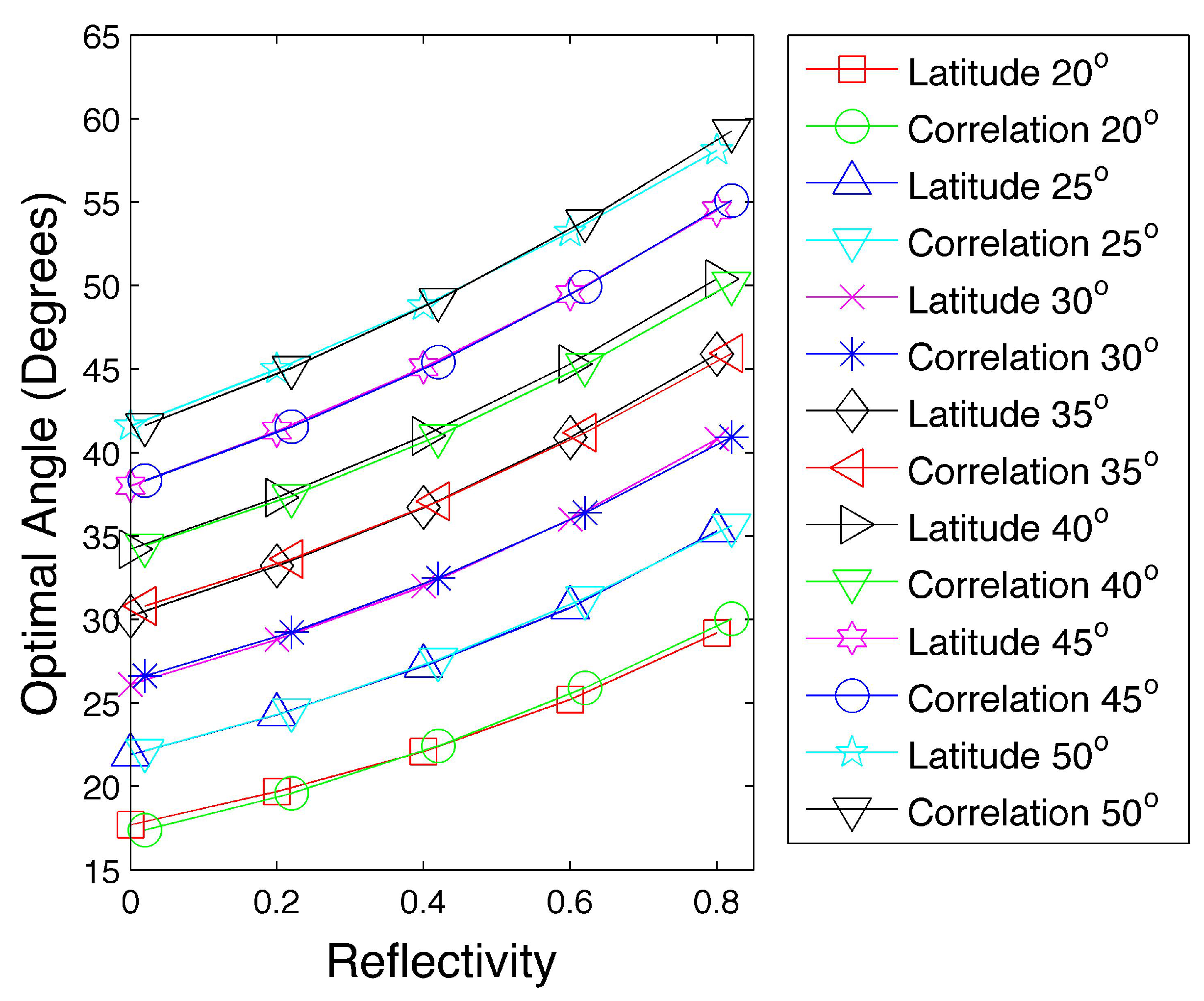2. Mathematical Model
The irradiance computation is based on the description provided by Stine [
15]. Bird and Hulstrom [
16] also describe a model which is downloadable through the National Research Energy Laboratory site [
17]. Relevant variables are listed in
Table 1. Let
δ be the angle of declination which is defined as the angle formed between the equatorial plane and the sun and computed using:
where
is the day of the year and the argument of the cosine is in degrees. Let
α be the solar elevation angle, which is defined as angle between the sun and the horizontal at latitude
ϕ and computed using [
15]:
Table 1.
Table of variables used in mathematical description.
Table 1.
Table of variables used in mathematical description.
| Symbol | Description |
|---|
| δ | Angle of Declination |
| α | Solar elevation angle |
| β | Angle of solar panel with respect to horizontal |
| γ | Angle of rotation of solar panel from due north |
| ρ | Surface reflectivity |
| θ | Angle between sun and solar panel normal |
| Zenith angle = |
| ϕ | Latitude |
| ω | Hour angle |
| A | Solar azimuth angle measured from due north |
| N | Day of the year |
The hour angle
ω is computed using
where
is the solar time,
based on the requirement that
when the sun is due south in the northern hemisphere. The cosine of the angle
θ between the solar panel normal and the sun is computed using:
where
β is the angle of the solar panel with respect to the horizontal and
γ is the angle of rotation of the solar panel from due north.
A is the solar azimuth angle (in degrees) computed using [
15]:
The total irradiance,
, on a solar panel is the sum of three components: a direct beam component (
), an isotropic diffuse component (
) and a reflected component (
) [
15,
The beam component is computed using Hottel’s clear model [
18]:
where
accounts for the eccentricity of the earth’s orbit,
and
We use coefficients for a clear atmosphere:
where
H is the elevation in kilometers. The diffuse component is computed using:
The reflected component
is composed of the reflectance
and a contribution from solar radiance on a flat plate:
Reflectivities of different surfaces can be found in [
19,
20] are are listed in
Table 2.
Table 2.
Reflectivity of common surfaces.
Table 2.
Reflectivity of common surfaces.
| Asphalt | Soil | Concrete (Weathered) | Grass | Sand | Old Snow | New Snow |
|---|
| 0.15 | 0.17 | 0.20 | 0.25 | 0.36 | 0.45–0.70 | 0.80–0.90 |
Our irradiance formulation is also used by Chang [
21]. One can integrate Equation (
3) over the entire year to compute the yearly energy per unit area:
3. The Influence of Reflectivity on the Optimal Tilt Angle
Using Equation (
3), one can construct a map of the irradiance on a solar panel throughout the year.
Figure 1 shows the yearly irradiance at a latitude of 30°, a tilt angle of 30°, and a reflectivity of
and a altitude of 1.62 km.
Figure 1.
Contour plot of irradiance as a function of day and time of day at a 30° tilt and a 30° latitude.
Figure 1.
Contour plot of irradiance as a function of day and time of day at a 30° tilt and a 30° latitude.
If the total irradiance is integrated over a year using Equation (
3), one can determine the angle at which the maximum energy is collected on a static solar panel. We assume that our solar panel is southward facing.
Taking the partial derivative of Equation (
6) with respect to
β and setting the equation to zero, one can derive the equation for the optimal angle,
which unfortunately involves integrals of transcendental functions. However, the graph of
in conjunction with Equation (
7) does allow us to conclude that an increase in
ρ will increase the optimal angle
β. We resort to numerical computations to determine the specific value of the optimal angle.
Figure 2 shows the integrated yearly irradiance as a function of the tilt angle at different reflectivities at a latitude of 40°.
Table 3 shows the optimal angle and integrated annual energy per unit area at different reflectivities which can be extracted from
Figure 2. The difference in the total integrated irradiance at the optimal angle is 1.9% between reflectivities of 0.2 and 0.4 and 4.1% between reflectivities of 0.2 and 0.6.
Figure 2.
Integrated irradiance as a function of tilt angle and reflectance at 40° latitude.
Figure 2.
Integrated irradiance as a function of tilt angle and reflectance at 40° latitude.
Table 3.
Optimal angle vs. reflectivity for 40° latitude.
Table 3.
Optimal angle vs. reflectivity for 40° latitude.
| Reflectivity | Optimal Angle(β) | kWh/m2 |
|---|
| 0 | | 2496 |
| 0.2 | | 2536 |
| 0.4 | | 2583 |
| 0.6 | | 2639 |
| 0.8 | | 2708 |
Since higher latitudes tend to accumulate snow in the winter, we perform a second study at a latitude of 40°. In the first part of the study, we maintain the reflectivity at 0.2 throughout the year. In the second part, we maintain the reflectivity at 0.2 in the summer months and 0.8 in the winter months for 180 days. The optimal angle for the first study is 37.3° with an annual yield of 2536 kWh/m
2. The optimal angle for the second study is 41° with an annual yield of 2581 kWh/m
2. The difference is only 1.8% in the annual yield at the different optimal angles. However, for comparison, we note that solar irradiation increases 4.1% if panel tilt angles are adjusted twice a year [
7].
Table 4 shows the optimal angle and integrated annual energy at different reflectivities at a latitude of 30°. The difference in the total integrated irradiance at the optimal angle is 1.2% between reflectivities of 0.2 and 0.4 and 2.7% between reflectivities of 0.2 and 0.6.
Table 4.
Optimal angle vs. reflectivity for 30° latitude.
Table 4.
Optimal angle vs. reflectivity for 30° latitude.
| Reflectivity | Optimal Angle(β) | kWh/m2 |
|---|
| 0 | | 2628 |
| 0.2 | | 2655 |
| 0.4 | | 2688 |
| 0.6 | | 2728 |
| 0.8 | | 2779 |
Figure 3 shows the integrated yearly irradiance as a function of the tilt angle at different reflectivities at a latitude of 20°. Note the difference in the vertical scale compared to
Figure 2.
Table 5 shows the optimal angle and integrated annual energy at different reflectivities at a latitude of 20°. The difference in the total integrated irradiance at the optimal angle is 0.6% between reflectivities of 0.2 and 0.4 and 1.4% between reflectivities of 0.2 and 0.6.
Figure 3.
Integrated irradiance as a function of tilt angle and reflectance at 20° latitude.
Figure 3.
Integrated irradiance as a function of tilt angle and reflectance at 20° latitude.
Table 5.
Optimal angle vs. reflectivity for 20° latitude.
Table 5.
Optimal angle vs. reflectivity for 20° latitude.
| Reflectivity | Optimal Angle (β) | kWh/m2 |
|---|
| 0 | | 2713 |
| 0.2 | | 2727 |
| 0.4 | | 2743 |
| 0.6 | | 2765 |
| 0.8 | | 2794 |
The maximum energy per unit area at the optimal angle is more sensitive to reflectivity at higher latitudes. At a latitude of 40°, a change of reflectivity between 0.2 to 0.6 can lead to a 4.1% increase in collected irradiation if the optimal angle is used. At a latitude of 20°, the gain is only 1.4%.
We summarize these results by plotting the optimal angle versus reflectivity and the maximum energy per unit area versus reflectivity at different latitudes. Using multiple regression, we design a correlation which allows the optimal angle (and maximum energy per unit area) to be computed based on reflectivity and latitude.
Figure 4 shows how the optimal angle changes with reflectivity at different latitudes. We plot both the data from the model and a quadratic multiple regression correlation for computing the optimal angle
,
where the latitude
ϕ is in degrees and the coefficients
and
f are given in
Table 6. We see that the correlation reproduces the model data well.
Figure 4.
Optimal angle as a function of reflectivity and latitude.
Figure 4.
Optimal angle as a function of reflectivity and latitude.
Table 6.
Coefficients for multiple regression correlation for optimal angle.
Table 6.
Coefficients for multiple regression correlation for optimal angle.
| a | b | c | d | e | f |
|---|
| –4.6230 | 1.2063 | 4.8992 | –0.00574 | 0.20679 | 8.0612 |
Figure 5 shows how the maximum energy per unit area changes at the optimal angle for different reflectivities at different latitudes. We plot both the data from the model and a multiple regression correlation for the maximum energy per unit area
at the optimal angle,
where
ϕ is in degrees and the coefficients
and
are given in
Table 7. Again we see that the correlation reproduces the model data well.
Figure 5.
Maximum energy per unit area at optimal angle as a function of reflectivity and latitude.
Figure 5.
Maximum energy per unit area at optimal angle as a function of reflectivity and latitude.
Table 7.
Coefficients for multiple regression correlation for maximum energy per unit area at optimal angle.
Table 7.
Coefficients for multiple regression correlation for maximum energy per unit area at optimal angle.
| | | | | |
|---|
| 2666.94 | 8.4470 | –113.25 | –0.31756 | 7.0728 | 103.85 |
While the optimal angle spans approximately the same range as the reflectivity varies at different latitudes (
Figure 4), the maximum energy per unit area in
Figure 5 does not. The range of maximum energy per unit area at different reflectivities is less at lower latitudes and more at higher latitudes. Energy gathered from solar panels at higher latitudes is more sensitive to the optimal tilt angle than at lower latitudes in regards to variations in reflectivity.














